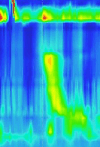Endoscopic ultrasound navigated application of botulinum toxin in severe esophageal motility disorder
- PMID: 39623145
- PMCID: PMC11785603
- DOI: 10.1007/s12328-024-02066-y
Endoscopic ultrasound navigated application of botulinum toxin in severe esophageal motility disorder
Abstract
The use of botulinum toxin in the therapy of esophageal motility disorders is reserved for elderly and comorbid patients considered risky for endoscopic or surgical treatment. However, there is a lack of data on the treatment of motility disorders outside the Chicago classification.We present the case of a 56-year-old patient with dysphagia and non-cardial chest pain (Eckardt 8). High resolution manometry ruled out achalasia or other motility disorder, but confirmed a localized 7-cm-long spastic segment in the upper to middle third of esophagus. We considered endoscopic or surgical therapy in this location too risky, therefore we decided to apply botulinum toxin into this segment. The spasm on high resolution manometry correlated with the thickened muscularis propria layer according to the endoscopic ultrasound. We used endoscopic ultrasound for the navigation of botulinum toxin application into the muscularis propria layer. We applied 100 IU of botulinum toxin into four quadrants, 20 and 24 cm from front teeth (12.5 IU for 1 application).The therapy led to improvement of symptoms (Eckardt 3) and to restitution of propulsive peristalsis with complete elimination of spastic segment. The worsening of symptoms appeared after 2 years, with subsequent recurrence of motility disorder fulfilling criteria of type II achalasia.Presenting this case, we wanted to point at the unique use of botulinum toxin as useful treatment in selected cases of unclassified esophageal motility disorder as a bridge therapy. Moreover, endoscopic ultrasound could be used to guide precise application of botulinum toxin.
Keywords: Botulinum toxin; Endoscopic ultrasound; Motility disorder of esophagus.
© 2024. The Author(s).
Conflict of interest statement
Declarations. Conflict of interest: The authors have no conflicts of interest to declare. Human and animal rights: Me, Diana Vážanová, confirm that all procedures used in my case report were in accordance with the ethical standards of the responsible committee on human experimentation (Institutional and National) and with the Helsinki Declaration of 1964 and later versions. Informed consent: Informed consent was obtained from patient who was included in our case report.
Figures





Similar articles
-
Botulinum toxin injection for hypercontractile or spastic esophageal motility disorders: may high-resolution manometry help to select cases?Dis Esophagus. 2015 Nov-Dec;28(8):735-41. doi: 10.1111/dote.12282. Epub 2014 Sep 12. Dis Esophagus. 2015. PMID: 25212219
-
Botulinum toxin for the treatment of hypercontractile esophagus: Results of a double-blind randomized sham-controlled study.Neurogastroenterol Motil. 2019 May;31(5):e13587. doi: 10.1111/nmo.13587. Epub 2019 Apr 11. Neurogastroenterol Motil. 2019. PMID: 30974039 Clinical Trial.
-
Treatment of symptomatic nonachalasia esophageal motor disorders with botulinum toxin injection at the lower esophageal sphincter.Dig Dis Sci. 1996 Oct;41(10):2025-31. doi: 10.1007/BF02093606. Dig Dis Sci. 1996. PMID: 8888717
-
Distal esophageal spasm.Curr Opin Gastroenterol. 2015 Jul;31(4):328-33. doi: 10.1097/MOG.0000000000000187. Curr Opin Gastroenterol. 2015. PMID: 26039725 Review.
-
Botox Injections for Esophageal Motor Disorders.Gastrointest Endosc Clin N Am. 2025 Jul;35(3):637-649. doi: 10.1016/j.giec.2025.02.004. Epub 2025 Mar 22. Gastrointest Endosc Clin N Am. 2025. PMID: 40412995 Review.
References
-
- Heddle R, Cock C. Role of botulinum toxin injection in treatment of achalasia. Ann Esophagus. 2020;3:26.
-
- Weusten B, Barret M, Bredenoord, et al. Endoscopic management of gastrointestinal motility disorders—part 1: European Society of Gastrointestinal Endoscopy (ESGE) Guideline. Endoscopy. 2020;52:498–515. - PubMed
-
- Zaninotto G, Bennett C, The BG, et al. ISDE achalasia guidelines. Dis Esophagus. 2018;2018:31. - PubMed
-
- Vaezi MF, Pandolfino JE, Vela MF. ACG Clinical guideline: diagnosis and management of achalasia. Am J Gastroenterol. 2013;108:1238–49. - PubMed
-
- Sadowski DC, Ackah F, Jiang B, et al. Achalasia: incidence, prevalence and survival. A population-based study: achalasia and epidemiology. Neurogastroenterol Motil. 2010;22:e256–61. - PubMed
Publication types
MeSH terms
Substances
LinkOut - more resources
Full Text Sources
Medical

